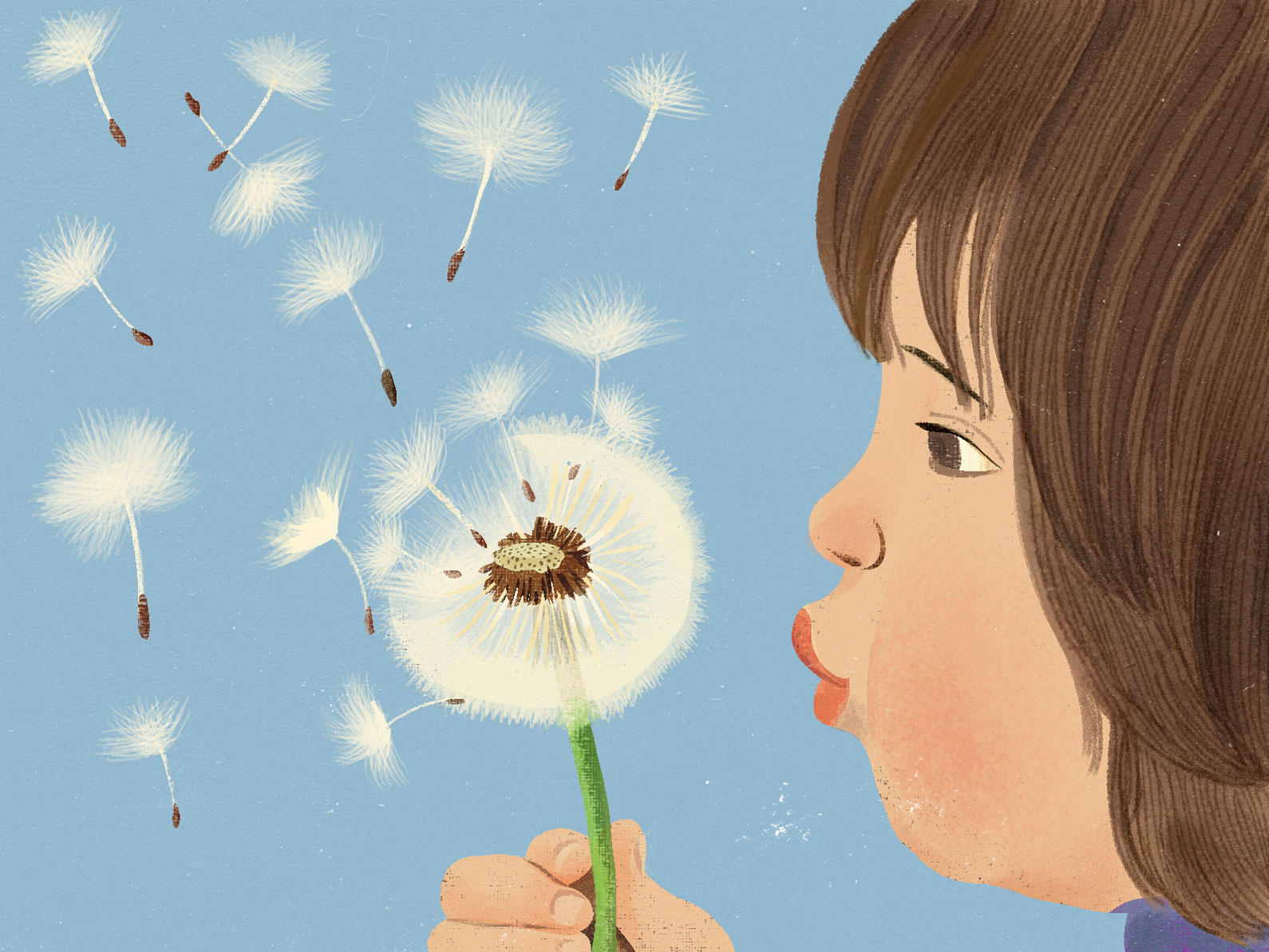Best of the Haiku Challenge (April 2022)
Announcing the winning poems from Tricycle’s monthly challenge The post Best of the Haiku Challenge (April 2022) appeared first on Tricycle: The Buddhist Review.

 Illustration by Jing Li
Illustration by Jing LiThe history of modern haiku forms a circle, not a line. Those poets who believed that haiku should lead to advances in the realm of human affairs have come around to the idea that haiku is, most fundamentally, a form of animism—the belief that a distinct “spiritual essence” infuses everything in Nature, including animals, plants, rocks, and even the weather.
The winning and honorable mention haiku for last month’s challenge captured the essential spirit of Nature’s most ubiquitous spring flower.
Nancy Winkler traces the taproot of a dandelion to a place of calm in the face of intractable modern problems. Tamar Enoch sees worlds ending and beginning everywhere as “dandelion puff” is set adrift on the spring air. Alex Lubman imagines a kingdom where silence intensifies the color of dandelions, giving them a “deeper gold.”Congratulations to all! To read additional poems of merit from recent months, visit our Tricycle Haiku Challenge group on Facebook.
You can submit a haiku for the May challenge here.
***
WINNER:
With its deep taproot
the dandelion stays calm
as its head explodes
— Nancy Winkler
It is difficult to explain why haiku did not go extinct around the turn of the 20th century. After all, it was a tradition-bound form of classical literature that did not engage with the realities of modern life. But survive it did. In fact, it flourished. Haiku became the dandelion of modern poetry, spreading its seeds to all levels of Japanese society and, later, throughout the world.
The reasons for its modern success are counterintuitive. In 1928, the poet Takahama Kyoshi described haiku with the phrase kacho-fuei, “poetic composition on birds and flowers,” thus reaffirming its core identity as a traditional (i.e., not modern) poetic form written in 5-7-5 syllables, including a season word.
Did Kyoshi understand that people needed a place to retreat from the pressures of rapid urbanization and industrialization? Intuitively, yes. He must have. The haiku form preserved a serene, well-ordered space, much like a public park, where people could go to contemplate their relationship to nature, even as nature became less and less a part of their lives.
In 1931, a new school of haiku emerged that rejected kacho-fuei. It shifted the focus of haiku from nature to humanity, making society its central subject. But even members of the New Haiku Movement used season words and adhered to the classical form more often than not.
Near the end of his life, the poet Kaneko Tota (1919-2018), who had been the harshest critic of Kyoshi’s approach, concluded that haiku had come full circle:
In today’s world of haiku, it seems to me that old-fashioned labels such as new or old generations or traditional or modern styles are disappearing, and that a new criterion of classification has emerged instead—that is, animists or non-animists. In my opinion, genuine haiku poets will eventually find themselves animists.
This is where we are today. Many still use haiku to reflect on society, but such “human-centered” haiku are not the future. Species extinction and climate change will make animists of us all.
This month’s winning haiku relies on the popular expression “makes my head explode” to refer to a problem so difficult that attempts to solve it produce extreme frustration. In a 2012 article for the journal Policy Sciences, researchers proposed the term “super wicked problem” to describe global challenges like climate change. Super wicked problems have four requirements:
There is a significant time deadline on finding the solution. There is no central authority dedicated to finding a solution. Those seeking to solve the problem are also causing it. Certain policies irrationally impede future progress.Seeing it laid out like that should give us pause. The overriding characteristic of a super wicked problem is that it is not likely to be solved by those who created it.
The seeding head of a dandelion is sometimes called a “clock” and sometimes a “globe”—metaphors that add darker nuances to an already dark poem. The clock is ticking while the world waits to see what will happen. But we already know what will happen. It is already happening now.
The taproots of dandelions are usually 6 to 18 inches long. But they can grow to depths of fifteen feet. Landscapers who regard dandelions as “nuisance flowers” quickly discover the futility of digging them up. If left in the ground, a one-inch piece of dandelion root (which is extremely brittle) will yield a four-fold increase of flowers in a matter of days.
Is the poet saying that human beings, even if they can’t solve head-exploding problems like climate change, are more resilient and adaptive than they know? Or is the dandelion globe a symbol for the planet’s capacity to re-seed itself after an extinction level event, restoring biodiversity over time? Possibly both meanings are implied.
Increasingly, haiku taps into our growing fascination with pre-modern modes of thinking about Nature and our place in it—from herbalism to shamanism to animism. At its best, the haiku life is a way of tapping into older, wiser ways of knowing, giving us the calmness that comes from following the rhythm of the four seasons.
HONORABLE MENTIONS:
One world demolished
A thousand set in motion
Dandelion puff.
— Tamar Enoch
The dandelions
in the kingdom of the deaf
are a deeper gold.
— Alex Lubman
♦
You can find more on April’s season word, as well as relevant haiku tips, in last month’s challenge below:
Spring season word: “dandelion”
Dandelion fluff:
to blow it away the chest
must expand with air
— Shigeki Aoyagi (b. 1929)
Submit as many haiku as you wish that include the season word “dandelion.” Your poems must be written in three lines of 5, 7, and 5 syllables, respectively, and should focus on a single moment of time happening now.
Be straightforward in your description and try to limit your subject matter. Haiku are nearly always better when they don’t have too many ideas or images. So make your focus the season word and try to stay close to that.
REMEMBER: To qualify for the challenge, your haiku must be written in 5-7-5 syllables and include the word “dandelion.”
HAIKU TIP: “ASSIMILATE THE SELF IN NATURE!”
I have re-translated the haiku cited above in order to preserve the order of the images in the original, which appears in A Hidden Pond: Anthology of Modern Haiku, edited by Koko Kato and David Burleigh. Published in 1997, the collection includes useful commentary and background information on each of its 230+ poems. Kato and Burleigh have since published a companion volume, The Earth Afloat: Anthology of Contemporary Japanese Haiku.
Taken together, the two books embrace the remarkable diversity of haiku as a “group art” in present-day Japan. Each featured poet is a member of an established haiku group that sponsors magazines, challenges, and monthly kukai (“poetry meetings”) where members gather to share their haiku. Within those groups, there is likewise a remarkable range of styles, as Japanese poets are encouraged to develop their own distinctive “haiku philosophy.”
Even so, certain ideas are foundational for modern haiku. The most basic of these involves using season words “to follow nature, and honor nature” throughout the four seasons of the year.
In their commentary on Aoyagi’s poem, Kato and Burleigh wrote:
The fluffy feathered seeds of a dandelion are also known as a dandelion clock. As they fly away, it seems that our hopes and dreams are lifting gently into the air. Each seed holds a new possibility, and spring is the season of renewal. The poet is the head of the ‘Mountain Calendar’ or Sanreki haiku group. He seeks, in his own words, ‘Nature as it is’ and ‘Assimilation of the Self in Nature.’
Aoyagi’s haiku focuses on a universal human experience within nature—picking a dandelion that has gone to seed in order to blow it to the breeze. There is something so irresistible about this childhood ritual that even an aging haiku master finds himself drawn back to it on a fine spring day. So he bends to pluck a dandelion globe and, holding it up to his lips, draws in a deep lungful of spring air.
This is the expansive, hopeful moment that Aoyagi has captured in his haiku. In the spring wind, the poet stands poised to add his little puff of air to send the dandelion seeds on their way. What better way to describe the “Assimilation of the Self in Nature.” No wonder the editors chose this poem as representative of Aoyagi’s philosophy of haiku.
A note on dandelions: Kato and Burleigh observe: “A wild plant, the dandelion is found throughout Europe, central and northern Asia, and North America. Its bright yellow flowers welcome the arriving spring.” Dandelions are a favorite subject for elementary school science curriculums because it is easy to chart the stages of their life cycle. Considered a nuisance by some, they are a source of beauty and an important food source for others. They can also be used to make wine!

Get Daily Dharma in your email
Start your day with a fresh perspective

Explore timeless teachings through modern methods.
With Stephen Batchelor, Sharon Salzberg, Andrew Olendzki, and more
![]()
Thank you for subscribing to Tricycle! As a nonprofit, we depend on readers like you to keep Buddhist teachings and practices widely available.
This article is only for Subscribers!
Subscribe now to read this article and get immediate access to everything else.
Already a subscriber? Log in.

 Lynk
Lynk 































